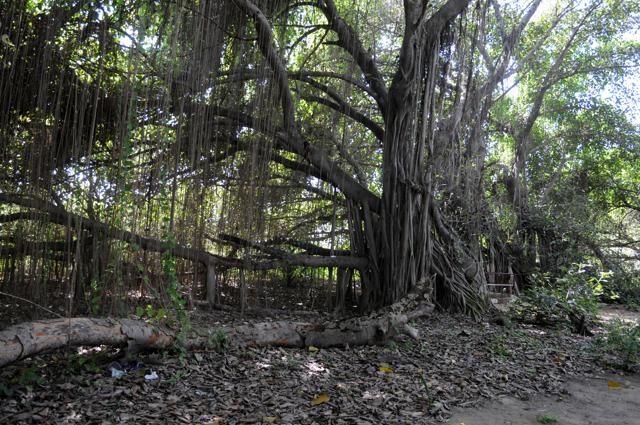Punjab’s own great banyan cries for conservation
The sprawling banyan in the remote village of Cholti Kheri in Fatehgarh Sahib district could well be the runner-up to the Great Banyan in the Indian Botanic Garden at Kolkata in terms of the area covered by the canopy. The much senior tree of Kolkata, estimated to be more than 1,200 years old, covers an area of 4 km, with the prop roots leading to a chain creating a unique heritage habitat.
Cholti Kheri (Fatehgarh Sahib): The sprawling banyan in the remote village of Cholti Kheri in Fatehgarh Sahib district could well be the runner-up to the Great Banyan in the Indian Botanic Garden at Kolkata in terms of the area covered by the canopy. The much senior tree of Kolkata, estimated to be more than 1,200 years old, covers an area of 4 km, with the prop roots leading to a chain creating a unique heritage habitat.

Its younger country cousin at Cholti Kheri, believed to be about 200 years old, although locals like to say it is more aged, has also thrown up its canopy over three to four acres of land. A visit to the village on Tuesday finds the gnarled old tree with its mini-forest of thousands of aerial roots touching the ground and new branches spreading at nature’s will. The banyan stands with pristine pride amid lush-green paddy fields.
Growing on farm land
The banyan has spread on private agricultural land and villagers make way for it by clearing the patch of fields where the wayward roots and stems move. There is a taboo against obstructing the banyan’s growth as the villagers believe that those who tried to do so in the past came to misfortune. Even the use of dead wood or fallen leaves is forbidden. Thus the tree has grown uninterrupted.
The banyan is India’s national tree and it has many myths, fables and religious beliefs attached to it. Although colloquially known as ‘bargad’ or ‘borh’, people of Cholti Kheri fondly call it ‘baroti baba’. Says Shamsher Kaur (60), whose family has given up some five marlas of their land to the banyan, “A Jat will not part even with an inch of land and a bitter dispute could ensue. She then adds with a smile, “But who will fight our baroti baba? What he claims is his own.”
Direly needs help
However, all is not well with the wizened banyan. The Punjab Biodiversity Board (PBB), while calling for biodiversity heritage status for the canopied tree, has also been making demands for its conservation. The PBB has been observing the site for several years and the tree is listed by its Sanskrit name, Kayakalp Vriksh (wish-fulfilment tree). A village biodiversity committee has been constituted with the help of the district administration.
Chief minister Parkash Singh Badal, presiding over a meeting of the PBB on Monday, called for an action plan for conserving the Kayakalp Vriksh and declaring it as a biodiversity heritage site. The other site recommended for heritage status is Inami Baag, which has 29 native mango varieties, at Bassi Umar Khan village in Hoshiarpur district. The proposal will have to be pursued with the National Biodiversity Authority.
Gurharminder Singh, senior scientific officer, PBB, points out: “The age is not the important factor because Punjab has older stand-alone trees. What makes it a subject of interest for environmentalists is its unique spread over a large area, providing an abode to peacocks, other birds, snakes and many micro-organisms.” However, he stresses the need to conserve it because it is prone to fungus attacks and the wild ‘giloy’ creeper spread over the trunks and branches is harmful.
Role of superstition
Superstition has played a positive and negative role in the protection and decline of the natural reserve. Gurmail Singh (70), a farmer, recalls how members of the Tarksheel (rationalist) Society came to the village several years ago and urged them to chop the spreading roots, assuring them that they would not come to harm. “No villager lifted an axe but told them that they may chop but the villagers would not. Finally, they left hearing the stories we told them of disasters that befell those who tried to meddle with the ‘baroti baba’,” he recounts with a laugh.
However, the belief that wishes are fulfilled in the banyan abode have started bringing money. A concrete temple and a dharamshala (resthouse for pilgrims) have come up right beside the tree. Gurharminder says, “We have cautioned the temple keeper and villagers that any more concrete construction may harm the banyan further.”
The sub rail track to cater to the power plant nearby is not desirable and of late fewer peacocks are spotted there, he adds. The tree has been the abode of sadhus for generations, but earlier it was in small thatched huts, not concrete structures.



